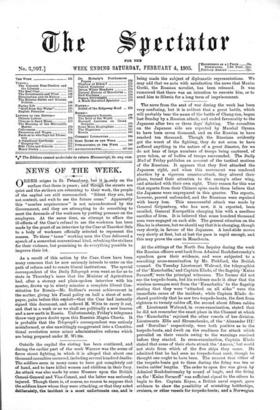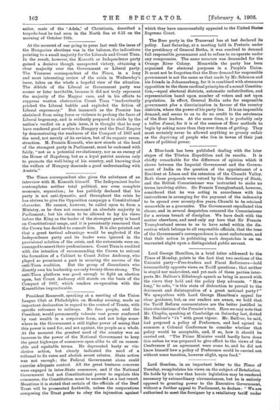At the sittings of the North Sea Inquiry during the
week the Russian officers sent back from Admiral Rozhdestvensky's squadron gave their evidence, and were subjected to a searching cross-examination by Mr. Pickford, the British counsel. On Tuesday Lieutenant Walrond, the telegraphist of the' Kamchatka,' and Captain Klado, of the flagship Kniaz Suvaroff,' were the principal witnesses. The former did not see the torpedo-boats, but his evidence made it clear that the wireless messages sent from the Kamchatka' to the flagship stating that they were "attacked on all sides" were the immediate cause of the incident; while Captain Klado de- clared positively that he saw two torpedo-boats, the first from eighteen to twenty cables off, the second about fifteen cables off. Lieutenant Walrond, in cross-examination, stated that be did not remember the exact place in the Channel at which the Kamchatka' rejoined the other vessels of her division. Lieutenants Ellis and Skramchenko, of the Alexander
and ' Borodino' respectively, were both positive as to the torpedo-boats, and dwelt on the readiness for attack which prevailed on their vessels owing to the warnings received before they started. In cross-examination, Captain Klado stated that some of their shots struck the 'Aurora,' bet could not state from which of the five ships they came. He admitted that he had seen no torpedo-boat sunk, though he thought one ought to have been. The nearest that either of the torpedo-boats got to them during the firing was ten or twelve cables' lengths. The order to open fire was given by Admiral Rozbdestvensky by sound of bugle, and the firing on the Sniaz Suvaroff' was sufficient signal to the others to begin to fire. Captain Keyes, a British naval expert, gave evidence to show the possibility of mistaking battleships, cruisers, or other vessels for torpedo-boats; and a Norwegian sailor, mate of the Adela,' of Christiania, described a torpedo-boat he had seen in the North Sea at 6.15 on the morning of October 19th.











































 Previous page
Previous page